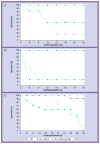Towards an understanding of the role of Clostridium perfringens toxins in human and animal disease
- PMID: 24762309
- PMCID: PMC4155746
- DOI: 10.2217/fmb.13.168
Towards an understanding of the role of Clostridium perfringens toxins in human and animal disease
Abstract
Clostridium perfringens uses its arsenal of >16 toxins to cause histotoxic and intestinal infections in humans and animals. It has been unclear why this bacterium produces so many different toxins, especially since many target the plasma membrane of host cells. However, it is now established that C. perfringens uses chromosomally encoded alpha toxin (a phospholipase C) and perfringolysin O (a pore-forming toxin) during histotoxic infections. In contrast, this bacterium causes intestinal disease by employing toxins encoded by mobile genetic elements, including C. perfringens enterotoxin, necrotic enteritis toxin B-like, epsilon toxin and beta toxin. Like perfringolysin O, the toxins with established roles in intestinal disease form membrane pores. However, the intestinal disease-associated toxins vary in their target specificity, when they are produced (sporulation vs vegetative growth), and in their sensitivity to intestinal proteases. Producing many toxins with diverse characteristics likely imparts virulence flexibility to C. perfringens so it can cause an array of diseases.
Figures









References
-
- McClane BA, Robertson SL, Li J. Clostridium perfringens . In: Buchanan RL, Doyle MP, editors. Food Microbiology: Fundamentals and Frontiers. 4. American Society for Microbiology; Washington, DC, USA: 2013. pp. 465–489.
-
- McClane BA, Rood JI. Clostridial toxins involved in human enteric and histotoxic infections. In: Bahl H, Durre P, editors. Clostridia: Biotechnology and Medical Applications. Wiley-VCH; Weinheim, Germany: 2001. pp. 169–209.
-
- Scharff RL. Economic burden from health losses due to foodborne illness in the United States. J Food Protect. 2012;75(1):123–131. - PubMed
-
- Carman RJ. Clostridium perfringens in spontaneous and antibiotic-associated diarrhoea of man and other animals. Rev Med Microbiol. 1997;8(Suppl 1):S43–S45.
Publication types
MeSH terms
Substances
Grants and funding
LinkOut - more resources
Full Text Sources
Other Literature Sources
